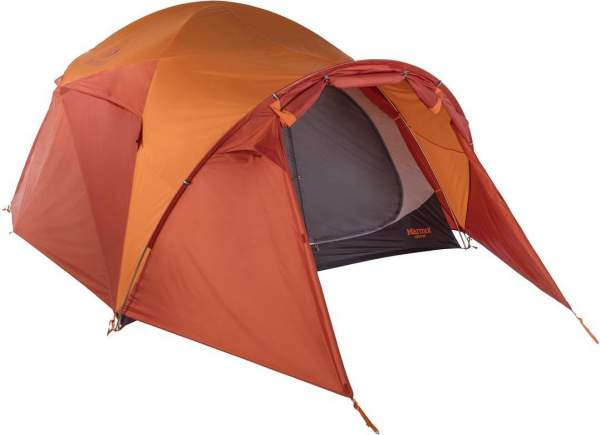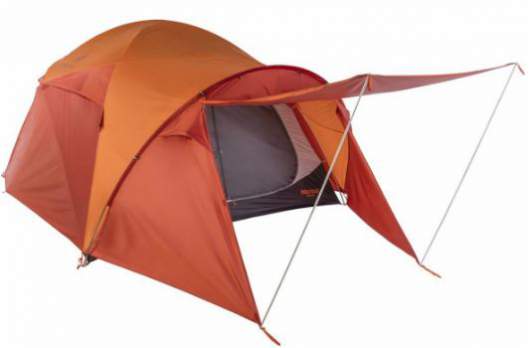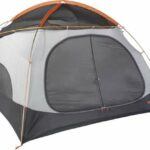This Marmot Halo 6 Person Tent Review is about the new version of the popular tent, that has been considerably improved. The doors are huge now and the tent comes with two large vestibules. It offers 96.7 + 64 ft² (9 + 6 m²) of the protected area.

Key features & benefits
- 2 large doors.
- 2 large vestibules.
- Full coverage fly.
- Full weather protection.
- Quality materials.
What this is about
The Marmot Halo 6 is a part of a series that has been around for at least 7 – 8 years already. It has been reshaped in the past, and this here is its 2018 version. So what is new? Well, the tent has been improved in several ways, but not all changes are an improvement, here are the most important ones:
- The new version is slightly heavier, some 300 grams or so.
- The new version is 14 cm lower.
- The new version is also a bit smaller, 5 cm in the two dimensions. So you have 100 ft² (9.3 m²) in the old version and 96.7 ft² (9 m²) in the new version.
- The floor fabric in the new version is much more durable, now you see why it is heavier.
- The doors on the new tent are huge, probably twice the size of the doors in the previous version.
- There are two symmetric vestibules in the new version.
So this was for those who were familiar with the previous version, now a few words for those who are new to this tent. The Halo 6 is a single room dome style tent with a full-coverage fly. This is a 3-season tent in the true sense, it should protect you in any weather conditions.

The structure is partly freestanding and this is because of the main poles that create the usual X-shape structure, so when you put them in the corner grommets, they are kept in place with the sleeves that go over the top of the tent. But there is an extra pole on the front which creates the large vestibule, see the picture below, and the side flaps of the vestibule must be staked to the ground to have a proper tension in the fly and to have the vestibule functional.
The word ‘halo’ in the name is due to the two extra brow poles that cross the main poles around the tent, creating a full circle. You can see them in the picture above.
Note that both versions are available on the market and you can see them here, so don’t get confused. The easiest way to know which is which are the doors, they are double-wide in the new tent. Observe that they have also launched the new version of their Marmot Halo 4 tent.
Who is it for
Sizewise, the tent offers 96.7 + 64 ft² (9 + 6 m²) of the protected area. The first number indicates the inner floor area. So this is 16 ft² (1.5 m²) per person, plus the storage area under the vestibules. Obviously, they have used the backpacking principle to determine the capacity of this tent.
It offers enough space for 6 people sleeping on the floor and you have the vestibules for storage, but for real camping you should reduce this number drastically, say to 3 or a maximum of 4 people. Note that this size is almost the same as in their Marmot Torreya 6 Person Camping Tent.
Seasons-wise, the tent is with the full coverage fly and the waterproof rating is quite good, so it should protect you from elements in any weather conditions in a 3-season use.

Weight-wise, the tent is heavy; you have 20 lb 1.3 oz (9.11 kg). You will see in the specifications they also give the minimum weight. If you are not familiar see more here, but this implies reducing the weight by leaving some elements at home. But this is still a heavy tool and you would not want to carry it anywhere.
This is a camping tent to be used at places with a motorized access. The packed size is really great, it is such that you can transport it even on a motorbike.
Construction & materials
The poles
I have already described them above, so here just to stress that you have them 5. Those are the top-notch DAC and DAC DA17. If you are not familiar, DAC is the leading poles manufacturer in the world, and the DA17 are special poles they developed for larger family camping tents. The pole diameter is 13 mm and 14.5 mm.
The two ‘halo’ poles create 4 intersections with the main dome poles and this makes the structure particularly stable. This principle with poles intersections is used in the construction of the winter dome tents, and this is not without reason.
The fabric
The canopy fabric is 40D 100% polyester No-See-Um mesh F/R, and 68D 100% polyester Taffeta F/R. The fly fabric is 68D 100% polyester ripstop with 1800 mm waterproof rating, also F/R. This is equivalent to around 2.7 PSI; if you are more familiar with this terminology, see more in my another text. So this is the same as in the previous 2017 version.
The front vestibule is with dual parallel zippers, so it allows for an awning configuration shown in one of the pictures above. You will use your trekking poles for this purpose.
But the catenary cut floor fabric is now 150D 100% polyester Oxford with 3000 mm rating and F/R, as compared to 70D nylon in the previous version. This is the same as 4.27 PSI.
More about tent materials you can see in this text.
Other features
There are several pockets in the corners, and yet another light pocket is above so you can put your headlamp there and have ambient light.
There are two zippered windows on the inner tent, and their purpose is only for ventilation. So these are double-layer structures. In combination with the vents on the fly and all the mesh on the doors and on the ceiling, you should have a good ventilation in spite of its full-coverage fly.
Specifications
- Type: dome style, freestanding.
- Capacity: 6 people.
- Max weight: 20 lb 1.3 oz (9.11 kg).
- Min weight: 19 lb 5 oz (8.76 kg).
- Dimensions: 118 x 118 in (300 x 300 cm).
- Floor area: 96.7 ft² (9 m²).
- Area per person: 16 ft² (1.5 m²).
- Peak height: 76 in (192 cm).
- Vestibule area: 32 + 32 ft² (3 + 3 m²).
- Packed size: 25 x 14 in (64 x 36 cm).
Final thoughts, rating, pros & cons
I would summarize this Marmot Halo 6 Person Tent review with the following: they have improved the tent in three important aspects, i) the floor is far stronger, ii) the doors are much bigger, and iii) the vestibules area is also bigger. But the tent is lower and the floor area is slightly reduced.
The tent is expensive as it has always been, but you should know that the new version is less expensive than the previous one. I have no doubts about its quality, I have trust in this brand. This is why I have added it to my list of the best dome camping tents.
See how I rate it:
If you want something completely different, please check these tents which follow a completely different concept, with a large living room and several sleeping rooms: Eurohike Hampton 6, and Vango Omega 500XL Tent with three rooms and 5000 mm waterproof rating.
Please let me know if you have any comment or question, there is a comment box below. Have a nice day.

Do you know what fire retardant chemical(s) are used on the Marmot Halo and with most tents manufacturers these days? For example, Marmot’s website includes a Chemical Management and Restricted Substance List – https://www.marmot.com/sustainability_product.html, but i can’t find any information for the chemicals used in their tent coatings. I want to go camping with my wife and kids, but would like to avoid contact with any harmful chemicals. Some tent companies flat out say that they don’t use fire retardants, but many do not which undoubtedly means that they are using fire retardant coatings of some sort. Any information listing the fire retardant chemicals commonly used on tents (in recent years) is greatly appreciated.
Hi Greg, this is an interesting topic and I think I shall write something about it.
From what I know, frequently used are Organophosphate flame retardants (OPFRs) like triphenyl phosphate (TPHP), tris(1,3-dichloro-2-propyl)phosphate (TDCIPP) and tris(2-chloroethyl)phosphate (TCEP). You will find more in this article. But there are many more, please see more here.
Thanks JV! I included another post below before I saw your reply from my initial post. I appreciate the information you provided and look forward to seeing more on this topic on your website!
I have written a separate text on this, please see it here.
I realize that there are so many products out there that have flame retardant coatings – cars, couches, etc. It’s hard to avoid in every day life and that sleeping in a tent with flame retardant coating a few times a year isn’t really a huge concern, but am still curious about tent products and the chemicals used to treat them.
Hi Greg, in fact, the same is with me, I personally am not much concerned, but this is an interesting topic. On the other hand, I normally do not go with anybody, my kids are grown up. So your concern is justified, and I understand you completely, I would also take care if this was about my kids.
Can you comment on how warm this tent is?
I would like to find something that fits my family of 4, and has space for a pack and play, too.
The big issue last time we went out was warmth for the 1 year old.
Would this tent keep the inside temperature at 50, if it is, say, 32 outside?
Hi Dave, there is no way to answer this without trying and measuring the temperature. Many factors play a role, like winds, humidity, the orientation of the tent, the number of people. But I would not use this tent for such a cold climate. Check some of these tents for cold weather camping.
I have a marmot 6p halo with rainfly. I would like to get the new and improved rainfly. Will it fit my 6p marmot halo?
Hi Terry, in my text about the new Marmot Halo 6, I gave the summary of changes. You realize that this is a rather different construction with an extra pole in the vestibule, it is also ower and smaller. But it is best that you contact Marmot and ask.